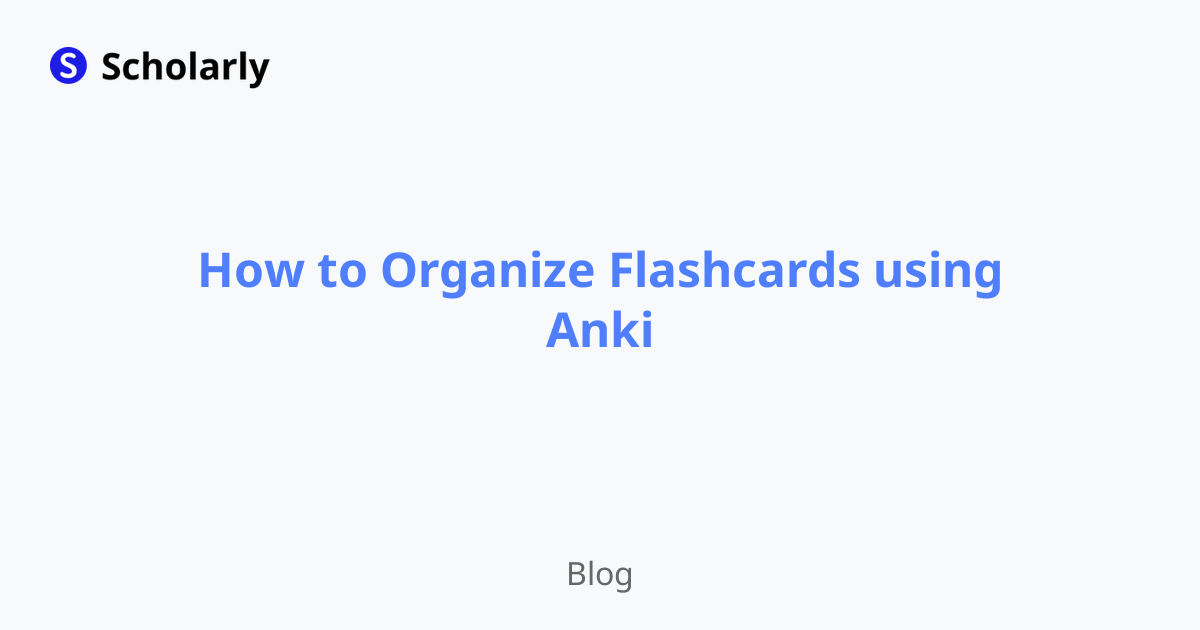How to Organize Flashcards using Anki
Learn how to organize flashcards using Anki to maximize your learning experience.

Flashcards are a valuable tool for studying and retaining information effectively. When it comes to flashcard organization, Anki is a popular and powerful software program that offers a range of features to help you stay organized and optimize your study experience. In this blog post, we'll explore how to organize flashcards using Anki to make the most of your study sessions.
Creating Flashcards in Anki
Before we delve into organizing flashcards, let's briefly cover the process of creating flashcards in Anki:
Download and install Anki: Start by downloading and installing the Anki software on your computer or mobile device. Anki is available for various platforms, including Windows, macOS, Linux, and mobile operating systems.
Create a new deck: Launch Anki and create a new deck to store your flashcards. Give the deck a descriptive name that reflects the subject or topic of the flashcards.
Add flashcards to the deck: Within the deck, click on the "Add" button to create new flashcards. Enter the question or prompt on one side of the card and the corresponding answer or information on the other side. Anki supports various formatting options, such as bold text, images, audio, and even mathematical equations.
Organize flashcards into subdecks: If you have a large number of flashcards or want to categorize them further, you can create subdecks within your main deck. Subdecks help you organize flashcards based on specific topics or chapters, allowing for better organization and focused study sessions.
Organizing Flashcards in Anki
Now that you have created your flashcards, let's explore how you can effectively organize them in Anki:
1. Tags
Anki allows you to add tags to your flashcards, providing a flexible way to categorize and organize them. Tags can represent topics, keywords, or any other relevant information related to your flashcards. Consider using consistent and descriptive tags to easily locate and review specific flashcards later.
2. Decks and Subdecks
Anki's deck and subdeck structure is a powerful organizational tool. You can create decks and subdecks within your main deck to group flashcards based on subjects, courses, or any other relevant categories. This hierarchical structure enables you to maintain a structured layout and easily navigate through your flashcards.
3. Customized Card Templates
Anki allows you to customize the appearance and layout of your flashcards using card templates. You can modify the font, colors, and styling to suit your preferences. Creating different card templates for different types of flashcards can help you visually distinguish between different categories or subjects.
4. Flags and Markers
Anki provides flags and markers that you can use to mark flashcards for specific purposes. For example, you can flag flashcards that require further review, mark important flashcards, or indicate flashcards that need revisions. Flags and markers serve as visual cues to prioritize certain flashcards or indicate their status in your study process.
5. Sorting and Filtering
Anki allows you to sort and filter your flashcards based on different criteria. You can sort flashcards alphabetically, by creation date, or based on their tags or other metadata. Filtering flashcards enables you to focus on specific subsets of your collection, such as flashcards from a particular deck or with specific tags.
Anki and Beyond
While Anki offers powerful features for flashcard organization, it's worth exploring other platforms to find the one that best suits your needs. Additionally, consider complementing your flashcard organization efforts with other study tools. One such platform is Scholarly, which provides advanced features like note-taking, flashcard recommendations, and AI tutoring.
Scholarly is an all-in-one platform that integrates note-taking and flashcards seamlessly. With Scholarly, you can create organized pages with flashcards as components, making it easy to manage and review your study materials. The AI tutoring feature further enhances your learning experience by providing personalized assistance and feedback.
To take your flashcard organization and studying to the next level, explore Scholarly alongside Anki. Visit scholarly.so to learn more about how Scholarly can transform your learning journey.
Happy organizing and studying!
Try Our Popular AI Study Tools
Transform your study materials into interactive learning experiences with our most popular AI-powered tools:
PDF to Flashcards
Convert lecture notes and textbooks into study flashcards instantly
Text to Flashcards
Turn any text or notes into comprehensive flashcard sets
Image to Flashcards
Convert diagrams and handwritten notes into digital flashcards
YouTube to Flashcards
Generate flashcards from educational video content



